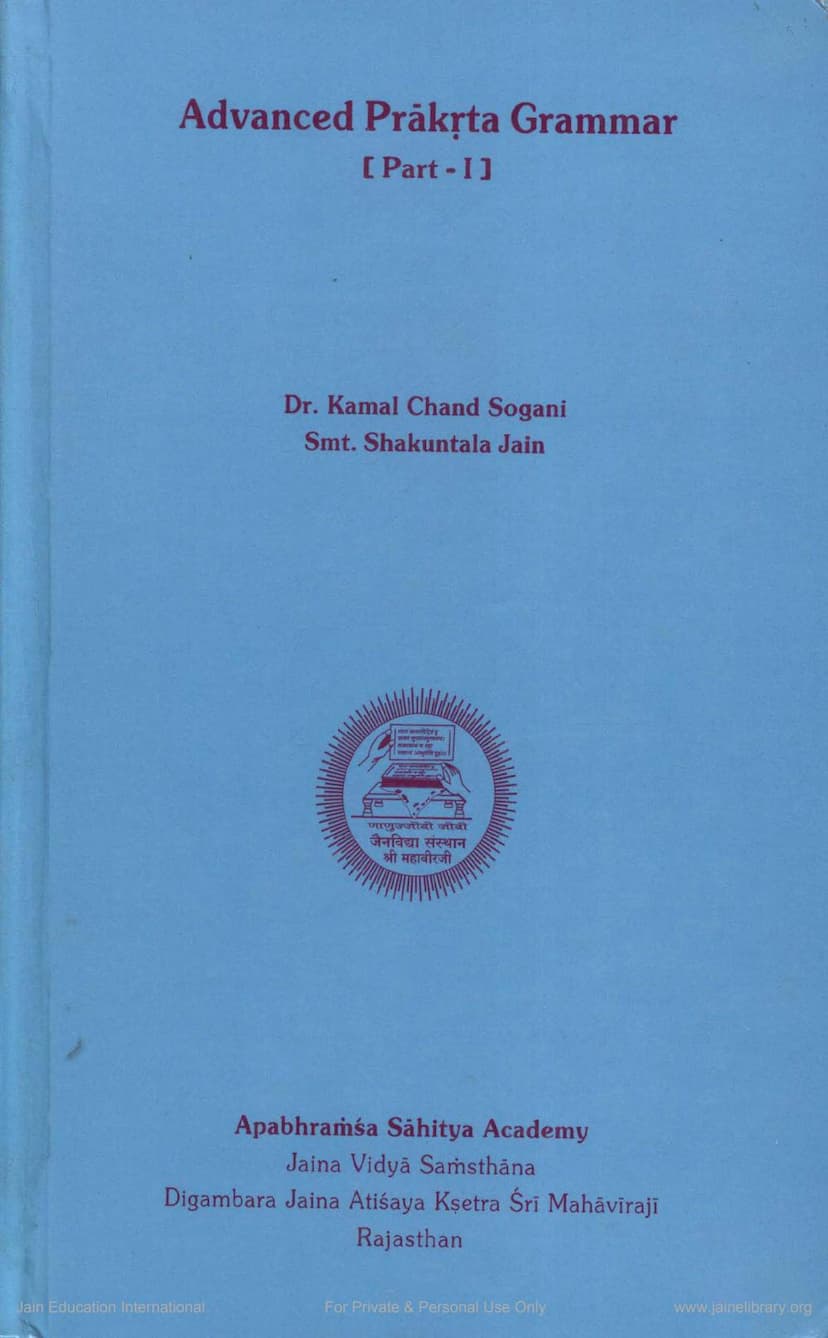Advanced Prakrit Grammar Part 1
Added to library: September 1, 2025
Loading image...

Summary
This document is an English translation of "Prauḍha Prākṛta Racană Saurabha Part-1," a comprehensive grammar of Prakrit language, specifically focusing on nouns, pronouns, and numerals. The book, authored by Dr. Kamal Chand Sogani and Smt. Shakuntala Jain and published by Apabhramsa Sahitya Academy, aims to provide a structured approach to learning Prakrit through an English medium.
Key aspects covered in this Part 1 include:
- Introduction to Prakrit: It highlights Prakrit as a rich, ancient, and sacred Indo-Aryan language, significant for understanding the development of Indian literature and the culture of the masses.
- Grammatical Foundations: The book outlines the essential grammatical categories of Prakrit, including:
- Alphabets: Vowels and consonants, with specific notes on the usage of 'na' and 'ña'.
- Numbers: Singular and Plural.
- Genders: Masculine, Feminine, and Neuter.
- Persons: First, Second, and Third.
- Cases: Eight cases (Nominative, Accusative, Instrumental, Dative, Ablative, Genitive, Locative, Vocative).
- Verbs: Transitive and Intransitive.
- Tenses: Present, Past, Future, Imperative, and Conditional.
- Words: Classified by their endings (a, ā, i, ī, u, ū).
- Sutra Analysis Method: Each sutra (grammatical rule) is analyzed in five steps: Sandhi (combination), Vibhakti (inflection), literal translation, contextual translation, and examples with notes.
- Declensional Patterns: The core of Part 1 focuses on the declension of nouns, pronouns, and numerals. It explains that Prakrit declensional patterns are largely based on Sanskrit models. The book details how various suffixes are inflected, referencing specific Sanskrit nouns like 'Hari', 'Bhubhṛt', 'Gopa', 'Rama', 'Stri', 'Guru', 'Matr', 'Rajan', 'Atman', 'Naman', 'Pitr', 'Kartr', and 'Pums' as paradigms.
- Detailed Declension Tables: Extensive tables are provided for:
- Nouns: Masculine (a-ending like Deva, i-ending like Hari and Gamani, u-ending like Sahu and Sayambhu), Neuter (a-ending like Kamala, i-ending like Vari, u-ending like Mahu), and Feminine (a-ending like Kaha, i-ending like Mai and Lacchi, u-ending like Dhenu, ū-ending like Bahu). It also covers special noun declensions like Piu (father), Bhau (brother), and agent nouns like Kattu (doer).
- Pronouns: Masculine, Neuter, and Feminine forms of pronouns like Savva, Ta, Na, Ja, Ka, Eta, Ea, Ima, Anna, Amu, Amha, and Tumha are meticulously detailed.
- Numerals: Cardinal numbers from one to eighteen, including their declensions in different genders and cases. It notes that the declension of some numerals follows specific rules or paradigms from nouns.
- Sūtras Covered: The book systematically presents and explains sutras related to:
- Section 1: Declension of thirteen nouns, pronouns, and numerals (Sutras 3/2 to 38, 41-43).
- Section 2: Declension of special nouns (Piu, Bhau, etc.) and agent nouns (Kattu, Dāu) and feminine nouns (Maa) (Sutras 3/39-48).
- Section 3: Declension of 'Raja' and 'Appa' (Sutras 3/49-57).
- Section 4: Pronominal declensions not covered in previous sections (Sutras 3/58-89).
- Section 5: Declension of personal pronouns 'Amha' (I) and 'Tumha' (You) (Sutras 3/90-117).
- Section 6: Declension of cardinal numerals Du (Two) to Pañca (Five) (Sutras 3/118-123).
- Section 7: Cases and their interchangeability (Sutras 3/130-137).
- Section 8: Negation of certain suffixes (Sutras 3/125-129).
- Section 9: Miscellaneous sutras related to combinations and general rules (Sutras 3/1, 3/124, 1/27, 1/84, 4/448).
- Section 10: Sutras pertaining to Śauraseni Prakrit (Sutras 4/260-264, 268).
- Appendices: The book includes appendices providing:
- Appendix 1: Detailed declensional forms of various nouns and pronouns.
- Appendix 2: Rules for ordinal numbers.
- Appendix 3: Rules of vowel and consonant combinations (Sandhi).
- Appendix 4: A summary of the grammatical analysis of the sutras.
- Diacritical Marks: A table explaining the diacritical marks used for vowels and consonants is provided.
The book emphasizes the systematic learning of Prakrit grammar, drawing parallels with Sanskrit to make the complex rules understandable to learners. It is presented as an essential resource for those seeking a deep understanding of Prakrit language and literature.